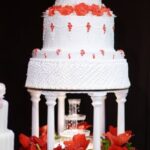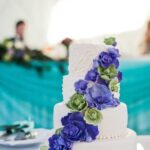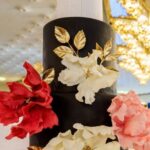Icing decorations have the power to take a cake from ordinary to extraordinary. In this article, we will explore the importance of icing decorations in cake design and how you can achieve professional-looking designs right at home. Whether you’re a beginner or an experienced baker, understanding the different types of icing and their uses in decorations is crucial.
We will also cover the essential tools and supplies you need to create stunning icing decorations, as well as step-by-step guides for basic and advanced techniques. So get ready to elevate your cake designs with beautiful icing decorations.
When it comes to cake design, icing decorations play a vital role in enhancing the overall appearance of any creation. They add texture, depth, and visual interest, turning an ordinary cake into a work of art. With the right techniques and tools, even amateur bakers can achieve professional-looking results that will impress everyone who sees your masterpiece.
Understanding the different types of icing is key to creating successful decorations. Buttercream is versatile and easy to work with, allowing for smooth finishes and intricate piping details. Royal icing dries hard and is perfect for creating delicate lace patterns or intricate designs that require stability. Fondant provides a sleek and modern look with its smooth finish, while ganache gives cakes a rich and glossy appearance.
In the following sections, we will delve into each type of icing in more detail and explore their uses in different decoration techniques. From basic decorating skills such as rosettes and swirls to advanced techniques like stringwork and brush embroidery, we will provide step-by-step instructions so you can master them all.
So let’s dive into the world of icing decorations. Equip yourself with the necessary knowledge, techniques, tools, and supplies needed to create stunning designs that will wow your friends, family, or clients. Get ready to bring your cake decorations to life.
Understanding the Different Types of Icing and Their Uses in Decorations
When it comes to icing decorations for cakes, there are different types of icing that can be used to achieve various designs and textures. Each type of icing has its own unique characteristics and uses in cake decorating. In this section, we will explore the versatility of buttercream, royal icing, fondant, and ganache, and discuss how to match the right type of icing with specific decoration techniques.
- Buttercream: Buttercream is a popular choice for icing decorations due to its smooth and creamy texture. It can be easily colored and flavored, allowing for endless creative possibilities. This type of icing is often used for piping borders, writing messages on cakes, creating rosettes or flowers, and making intricate designs. It is important to note that buttercream softens at room temperature, so it might not be suitable for intricate designs that require firmness.
- Royal Icing: Royal icing is a smooth, hard-setting icing made from powdered sugar and egg whites or meringue powder. It dries into a firm finish and is perfect for creating detailed decorations like flowers, lace patterns, or piped ornaments that need to hold their shape. Royal icing can also be used to create delicate stringwork designs by piping fine lines or lattices onto a cake.
- Fondant: Fondant is a pliable sugar dough that can be rolled out and draped over cakes to create a smooth finish. It is an excellent choice for covering wedding cakes or creating sculpted decorations like figures or bows. Fondant provides a sleek and polished look to cakes but does not have the same flavor as other icings like buttercream or royal icing.
- Ganache: Ganache is a rich mixture of chocolate and cream that can be poured over cakes as a glaze or whipped into a frosting-like consistency for spreading or piping designs. Ganache adds a decadent and glossy finish to cakes, making it ideal for elegant or formal occasions. It can also be used as a filling between cake layers for added flavor and texture.
Different types of icing have different purposes in cake decoration. By understanding the characteristics and uses of each type, you can select the right icing for your desired design. Experimenting with different icings will help you discover your personal style and achieve professional-looking icing decorations that will impress your family and friends.
Essential Tools and Supplies for Creating Icing Decorations
Creating beautiful icing decorations for cakes requires having the right tools and supplies on hand. Whether you’re a beginner or an experienced cake decorator, here is a comprehensive list of must-have items that will help you achieve professional-looking icing decorations:
- Piping Bags: These are essential for transferring icing onto your cakes. Look for reusable piping bags made from durable materials such as silicone or nylon.
- Piping Tips: There are numerous piping tips available in different shapes and sizes, each creating a unique effect. Start with basic round and star tips, and gradually expand your collection as you gain more experience.
- Icing Smoother: This tool helps create smooth finishes on buttercream cakes. It is particularly useful for achieving clean edges and sharp corners.
- Offset Spatula: An offset spatula is perfect for spreading icing or ganache evenly on the surface of a cake. Its angled shape allows for better control and precision.
- Fondant Tools: If you plan on working with fondant, invest in fondant smoothers, rolling pins, cutters, and embossing tools. These will help you manipulate fondant into different shapes and patterns.
- Paint Brushes: Various sizes of food-safe paintbrushes will come in handy when using techniques like brush embroidery or applying edible glitter to your decorations.
- Angel Food Cake Cutter: This specialized cutter is specifically designed to make clean cuts through delicate angel food or sponge cakes without causing them to compress or lose their shape.
Once you have gathered these essential tools, it’s important to know where to find them. Many specialized cake decorating supply stores offer a wide range of tools and supplies specifically tailored for icing decorations. Alternatively, you can also find them in craft stores or order them online from reputable cake decorating websites.
Remember, investing in quality tools and supplies will greatly impact the outcome of your icing decoration. Don’t be afraid to try new techniques and experiment with different tools to discover the ones that work best for you. With practice and the right equipment, you’ll be on your way to creating stunning and professional-looking icing decorations for all your cakes.
Step-by-Step Guide
When it comes to creating beautiful icing decorations for cakes, mastering basic techniques is essential. In this step-by-step guide, we will explore some simple yet impressive icing decoration techniques that will elevate your cake designs.
- Rosettes: This classic and versatile decoration is perfect for adding a touch of elegance to any cake. To create a rosette, start by attaching a piping tip to a pastry bag filled with buttercream or royal icing. Hold the bag at a 90-degree angle to the surface of the cake and apply even pressure while piping in a circular motion. Continue piping until you have achieved the desired size for your rosette.
- Swirls: Swirls are another simple yet visually appealing icing decoration that can be used on various cake designs. Using a round or star piping tip, squeeze the pastry bag while adopting an up-and-down motion to create swirls on the cake’s surface. You can vary the size and density of the swirls to add depth and dimension to your design.
- Piping Techniques: Piping techniques are fundamental in icing decoration. Practice creating straight lines, curved lines, and intricate shapes using different piping tips. Experiment with different pressures on the pastry bag to achieve different textures – from smooth lines to ruffled edges.
By mastering these basic icing decoration techniques, you will gain confidence in your skills and be able to create stunning designs on any cake. Remember, practice makes perfect, so don’t hesitate to try out different patterns and combinations.
Advanced Icing Decoration Techniques
Once you have mastered the basic icing decoration techniques, it’s time to take your designs to the next level with advanced techniques. These techniques will allow you to create intricate and impressive decorations that will surely impress your friends and family. In this section, we will introduce some advanced icing decoration techniques and provide tips and tricks for achieving precision and intricate details.
One technique that can elevate your cake designs is stringwork. Stringwork involves creating delicate lines or strings of icing that form beautiful patterns on the cake. This technique requires a steady hand and a lot of practice, but with time and patience, you can achieve stunning results.
To create stringwork, you will need a small round tip and royal icing that has been thinned to a piping consistency. Start by piping a straight line on the cake as your guide, then use gentle pressure to pipe thin lines parallel to the guide line, connecting them at regular intervals.
Another advanced technique is brush embroidery, which adds an elegant touch to any cake design. Brush embroidery involves using a soft-bristled brush to gently spread royal icing on the surface of the cake, creating a textured effect that resembles embroidery. To achieve this effect, start by piping a thick line or shape onto the cake using royal icing.
Then, use a dampened brush to flatten and spread the icing outward in a sweeping motion. The end result should be a soft, brushed texture that adds depth and dimension to your design.
Lastly, stenciling is another advanced technique that can add complexity and visual interest to your cake decorations. Stenciling involves using pre-designed stencils or creating your own patterns to apply icing onto the surface of the cake. To stencil on a cake, secure the stencil firmly against the cake’s surface using toothpicks or masking tape.
Then, use an offset spatula or palette knife to spread buttercream or royal icing over the stencil, ensuring even coverage. Carefully remove the stencil to reveal a beautifully patterned design on your cake.
These advanced icing decoration techniques require practice and patience, but they can take your cake designs to new heights. Remember to start with smaller designs and gradually work your way up to larger and more intricate ones.
Don’t be afraid to experiment with different techniques and combine them to create unique and personalized designs that are sure to impress. With dedication and a bit of creativity, you can master these advanced techniques and create stunning icing decorations for all occasions.
Creative Icing Decoration Ideas for Different Occasions
When it comes to cake decorating, the possibilities are endless. With icing decorations, you can add a personal touch and make any cake truly special. Whether you’re celebrating a birthday, a wedding, or a holiday, here are some creative icing decoration ideas for different occasions that will surely impress your guests.
For birthday cakes, one fun and popular idea is to add personalized icing messages and patterns. Use different colors of buttercream icing to pipe out the birthday person’s name or age on top of the cake. You can also create patterns like polka dots or stripes using various piping tips.
Another idea is to use fondant icing to create shaped decorations that reflect the birthday person’s interests or hobbies. For example, if they love sports, make small fondant soccer balls or basketballs and arrange them around the cake.
When it comes to wedding cakes, delicate lace and floral decorations are always a hit. Use royal icing or fondant to create intricate lace designs that wrap around the tiers of the cake. You can either pipe the designs directly onto the cake or make them separately and attach them with a dab of royal icing. For floral decorations, consider making gum paste flowers or using edible flowers like roses or pansies as cake toppers.
During holiday seasons, you can showcase festive icing designs on your cakes. For Christmas cakes, create a winter wonderland scene by piping snowflakes all over the cake using white royal icing. Add some red holly berries made from buttercream for pops of color. For Halloween cakes, use black fondant or black buttercream to create spooky shapes like bats or spiderwebs on top of an orange-frosted cake.
These creative ideas for different occasions will surely help you elevate your cake decorating skills and impress your family and friends. Remember to experiment with different techniques and have fun with it – after all, cake decorating is all about bringing joy through deliciously beautiful creations.
| Birthday Cakes | Wedding Cakes | Holiday Cakes |
|---|---|---|
| – Personalized icing messages and patterns | – Delicate lace and floral decorations | – Winter wonderland scene with snowflakes |
| – Use colors and patterns to reflect interests or hobbies | – Using gum paste flowers as cake toppers | – Spooky shapes like bats or spiderwebs for Halloween cakes |
Troubleshooting Common Issues with Icing Decorations
Addressing Challenges with Bleeding Colors
One of the common issues that cake decorators face when working with icing decorations is bleeding colors. This occurs when the colors used in the decorations start to blend together or run, resulting in a messy and unprofessional look. To prevent bleeding colors, it is important to use gel food coloring instead of liquid food coloring. Gel food coloring has a more concentrated pigment, which helps prevent the colors from spreading.
Another helpful tip is to allow each color to dry completely before adding another one. This will ensure that the colors stay separate and do not blend together. If you need to add multiple colors to a single icing decoration, consider using techniques such as layering or creating barriers with piping gel to prevent them from mixing.
If you still encounter bleeding colors despite these precautions, there are a few solutions you can try. One option is to carefully remove any excess color by gently blotting the affected area with a clean paper towel or cotton swab. You can also try using an airbrush gun to apply the colors instead of traditional methods like paintbrushes or piping bags, as this can help create more precise and controlled applications of color.
Tackling Cracked Fondant
Cracked fondant is another common issue that can affect the appearance of your icing decorations. Fondant has a tendency to crack when it becomes too dry or when it is stretched too thin. To avoid cracked fondant, make sure to knead and roll it until it reaches a pliable consistency before applying it to your cake.
If you notice cracks forming as you cover your cake with fondant, don’t panic. You can try gently smoothing out the fondant by using your hands or a fondant smoother tool. Additionally, using a small brush dipped in water can help seal the cracks and blend them into the surrounding fondant.
To prevent cracks from occurring in the first place, it is important to properly prepare your cake before applying fondant. Make sure to apply a thin layer of buttercream or ganache as a base, which will help the fondant adhere smoothly and prevent cracking.
Fixing Broken Piped Designs
Piping designs onto cakes using icing can be a delicate process, and sometimes the piped designs may break or collapse. To fix broken piped designs, first assess the extent of the damage. If only a small portion of the design is affected, you can carefully scrape off the broken part with a small palette knife and then re-pipe over it.
For more serious breaks or collapses, you may need to remove the entire design and start over. Use a clean damp cloth or paper towel to wipe off the broken icing, making sure not to damage any surrounding decorations. Then, pipe fresh icing onto the cleaned area and carefully recreate the design.
Preventing broken piped designs can be achieved by practicing proper technique and using the right consistency of icing. Make sure your icing is not too soft or runny as this can cause your design to collapse. Conversely, if it is too stiff or dry, it may crack or break easily. Experiment with different consistencies until you find one that holds its shape without being overly stiff.
By addressing common issues such as bleeding colors and cracked fondant, and knowing how to fix broken piped designs, you will be able to troubleshoot these problems when making icing decorations for cakes. With practice and patience, you can overcome these challenges and create stunning professional-looking cake designs that are sure to impress.
Pro Tips for Making Icing Decorations Look Professional
Within the world of cake design, icing decorations play a crucial role in elevating the overall appearance of a cake. Whether you are a baking enthusiast or a professional baker, learning how to create professional-looking icing decorations is essential. By following these pro tips, you can take your icing decorations to the next level and make your cakes truly standout.
Techniques for Achieving Smooth Finishes
One key aspect of creating professional icing decorations is achieving smooth finishes on your cakes. This can be achieved through several techniques. One popular method is called crumb coating, which involves applying a thin layer of icing to seal in any loose crumbs before applying the final coat. This ensures that your cake appears clean and polished.
Another technique for achieving smooth finishes is using an offset spatula or a bench scraper to smooth out the icing. Start by applying an even layer of icing and then gently scrape off any excess along the sides using the spatula or scraper. This will create a smooth surface that is ready for further decoration.
Tips for Sharp Edges
Having sharp edges on your cake adds to its professional look. To achieve this, make sure that your cake layers are evenly leveled before stacking them with filling in between.
Once stacked and filled, apply a thin layer of icing around the sides and top of the cake, known as a crumb coat, and chill it in the refrigerator for about 20 minutes. This will help set the crumb coat and prevent any loose crumbs from interfering with the final layer of icing.
After chilling, apply another thicker layer of icing on the sides and top, ensuring that it is as smooth as possible. Use an offset spatula to carefully run it along the sides at a slight angle to create sharp edges. The key here is patience and precision – take your time to achieve crisp lines.
Proper Storage and Transport
Once you have created your beautiful icing decorations, it is important to know how to properly store and transport your cake. To maintain the freshness of your icing, store the cake in a cool, dry place away from direct sunlight. If you are not planning to serve the cake immediately, you can refrigerate it but be sure to handle it with care when taking it out.
When transporting a cake with icing decorations, use a sturdy cake box or container that is larger than the size of the cake. This will provide enough space to accommodate any decorative elements on top of the cake and prevent them from getting smudged or ruined during transportation. Secure the cake box with tape or other fastening methods to ensure stability and minimize movement.
By following these pro tips for making icing decorations look professional, you can create stunning cakes that impress both visually and taste-wise. Remember to take your time, practice patience, and let your creativity shine through as you bring your cake decorations to life.
Conclusion
In conclusion, learning how to make icing decorations for cakes is an essential skill for anyone looking to elevate the overall appearance of their baked creations. With the right knowledge and tools, it is possible to achieve professional-looking icing decorations at home. Throughout this article, we have explored the different types of icing and their uses in decorations, discussed the essential tools and supplies needed, and provided step-by-step guides for both basic and advanced icing decoration techniques.
By following the tips and tricks shared in this article, you can take your cake designs to the next level. From personalized messages and patterns on birthday cakes to delicate lace and floral decorations on wedding cakes, there are countless creative ideas you can explore. Additionally, holiday cakes provide a great opportunity to showcase festive icing designs that will impress your friends and family.
It is important to remember that troubleshooting common issues with icing decorations is part of the learning process. Bleeding colors, cracked fondant, or broken piped designs may occur at times, but with practice and knowledge of solutions, these challenges can be overcome.
Ultimately, making icing decorations for cakes allows you to bring your own unique vision to life. Don’t be afraid to experiment and let your creativity soar. With each creation, you will improve your skills and develop your personal style as an icing decorator. So go ahead, gather your tools, unleash your imagination, and start creating stunning icing decorations that will amaze everyone who sees them.
Frequently Asked Questions
How do you make decorations out of frosting?
Making decorations out of frosting requires a steady hand and some basic techniques. Start by preparing the frosting, ensuring it is of the right consistency – not too runny or too stiff. Transfer the frosting into a piping bag fitted with a desired tip that suits the decoration you want to create. Hold the bag firmly with a relaxed grip and apply gentle pressure to pipe the frosting onto your cake or cookie.
Use smooth strokes or gentle squeezes to make various designs like flowers, stars, or borders. For more intricate designs, practice on parchment paper before attempting them directly on your baked goods. Remember to have fun and be patient as decorating with frosting can take some practice to master!
How do you mix icing sugar for decorations?
To mix icing sugar for decorations, begin by sifting the icing sugar using a fine-mesh sieve to remove any lumps or clumps. This will ensure a smooth and evenly mixed final product. Then, transfer the sifted icing sugar into a mixing bowl, making sure it is large enough to accommodate additional ingredients if necessary.
Add small amounts of liquid at a time – this can be water, milk, lemon juice, or any other desired flavoring agent – while whisking vigorously until you achieve your desired consistency. If the mixture becomes too runny, add more sifted icing sugar gradually until you reach the right thickness for piping or spreading onto your baked goods.
What kind of icing do you use for cake decorating?
When it comes to cake decorating, there are several types of icing that can be used depending on personal preference and desired results. Buttercream icing is one of the most common choices as it is versatile and easy to work with. It can be made by combining butter, icing sugar (powdered sugar), vanilla extract, and sometimes milk or cream for added moisture and smoothness. Swiss meringue buttercream is another option that results in an ultra-smooth texture but requires more steps in its preparation compared to regular buttercream.
Fondant icing is commonly used to cover cakes with a smooth, glossy finish and is often used for intricate decorations. Royal icing, which hardens when dried, is perfect for creating detailed piped decorations or for attaching edible embellishments like flowers or small figurines onto cakes. Other options include ganache, cream cheese icing, and whipped cream frosting – each offering its unique characteristics to enhance cake decor. It’s important to consider the flavor and texture of the cake as well as personal preferences when selecting the type of icing for cake decorating.

Welcome to my blog about home and family. This blog is a place where I will share my thoughts, ideas, and experiences related to these important topics. I am a stay-at-home mom with two young children. I hope you enjoy reading it! and may find some helpful tips and ideas that will make your home and family life even better!





